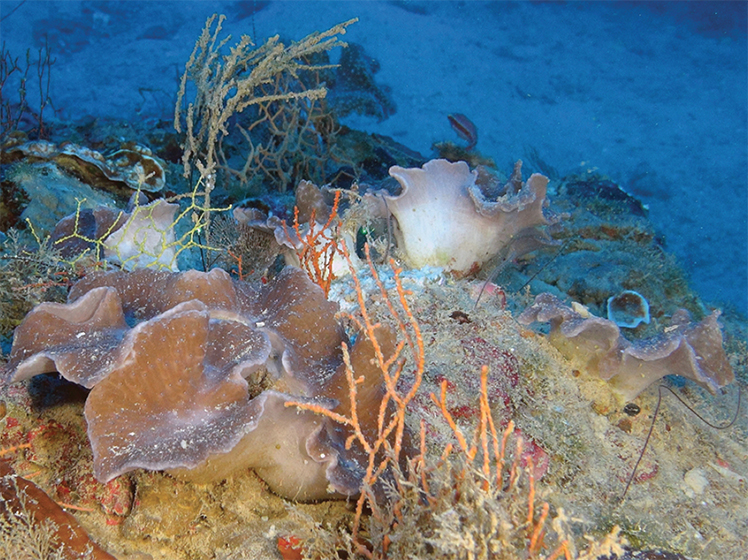Biologists Use Latest Technology to Discover and Differentiate Coral Species
July 6, 2017
Coral reef expert and Harvey Mudd College biologist Catherine McFadden is using the latest technological advances to delve deeper into the complex and diverse field of corals and their habitats. Working with collaborators on campus and around the world, McFadden has turned recent discoveries into three published papers, two of which reveal new species found in a previously unexplored region.
The companion papers—“Search for mesophotic octocorals (Cnidaria, Anthozoa) and their phylogeny: I. A new sclerite-free genus from Eilat, northern Red Sea” by Yehuda Benayahu, Catherine S. McFadden and Erez Shoham; and “Search for mesophotic octocorals (Cnidaria, Anthozoa) and their phylogeny. II. A new zooxanthellate species from Eilat, northern Red Sea” by Yehuda Benayahu, Catherine S. McFadden, Erez Shoham and Leen P. van Ofwegen—were published in the online journal ZooKeys and describe new species from low-light (mesophotic) coral reefs found at 30 to 200 meters, deeper than can be reached by conventional SCUBA diving but shallower than most deep-sea expeditions are designed to sample. The papers demonstrate a high octocoral richness in the Red Sea, where scientists are using new methods of exploration. Remotely operated vehicles now allow high-resolution cameras to take images at deeper depths, and technical diving (the use of new breathing technology and gas mixtures) allows humans to dive deeper and explore for longer time periods.
“People have been using these methods to go deeper and are finding that these deep reef areas are hugely diverse,” says McFadden, Vivian and D. Kenneth Baker Professor in the Life Sciences. She works with an international team of research scientists to investigate the origins of the phylum Cnidaria—one of the most primitive groups of animals on Earth—which includes jellyfish, Hydra, sea anemones and corals, her specialty. McFadden’s area of expertise is octocoral phylogeny, and she has been using molecular data to try and understand the evolutionary relationships and species boundaries among groups of soft corals from the North Atlantic, the Mediterranean and the tropical Indo-West Pacific.
“There’s exciting work going on in different parts of the world as we explore mesophotic reefs, mostly in the tropics. For instance, the Great Barrier Reef is three times larger than we knew,” she says. “Once you start looking at 60 meters depth, there’s an awful lot more coral down there. We’re really just starting to understand the ecology of these communities.”
McFadden and Yehuda Benayahu, a life sciences faculty member at Tel Aviv University in Israel, have worked together for many years, he studying the anatomy and physical features of new species and she doing genetic work to establish if they are new species and to figure out how they fit into the evolutionary scheme of things. “We hadn’t thought that most reef building corals could survive deeper than about 30 meters where you start to lose most of the light,” says McFadden. “What we’re finding is many species do go deeper into lower light areas than had been known or expected.”
Looks can be deceiving
For another project, McFadden and fellow researchers—one of which was a Harvey Mudd student (now a biology alumna, Alexandra Reynolds ’11)—are using modern methods to define species, since identifying them based on appearance is often incorrect. Using next-generation DNA sequencing technology, “we find things that we thought were different species that we can’t find any genetic differences between, and we find things that we thought were the same species that are genetically very different,” says McFadden.
Published in the journal Molecular Phylogenetics and Evolution (April 30, 2017), the paper “Species boundaries in the absence of morphological, ecological or geographical differentiation in the Red Sea octocoral genus Ovabunda (Alcyonacea: Xeniidae)” investigates 11 species of soft corals from the Red Sea that had been described based on physical appearance. By sequencing their genes, the researchers found that only four of the 11 are genetically different and clearly different species, yet they look identical. “So, that leads to the question ‘why,’ which we can’t answer at this point,” McFadden says.
In addition to a consistent volume of published work, McFadden has received a number of prestigious grants. In 2015, The National Science Foundation awarded McFadden a $494,481 collaborative grant with the American Museum of Natural History to study how environmental conditions in the distant past may have affected the evolutionary development of corals and sea anemones—research that will help shed light on how current climate change endangers coral reefs and the rich sea life they support.
